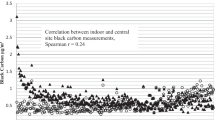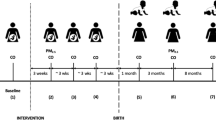Abstract
Background
Residential wood stove use has become more prevalent in high-income countries, but only limited data exist on indoor exposure to PM2.5 and its components.
Methods
From 2014 to 2016, we collected 7-day indoor air samples in 137 homes of pregnant women in Northern New England, using a micro-environmental monitor. We examined associations of wood stove use with PM2.5 mass and its components [black carbon (BC), organic and elemental carbon and their fractions, and trace elements], adjusted for sampling season, community wood stove use, and indoor activities. We examined impact of stove age, EPA-certification, and wood moisture on indoor pollutants.
Results
Median (IQR) household PM2.5 was 6.65 (5.02) µg/m3 and BC was 0.23 (0.20) µg/m3. Thirty percent of homes used a wood stove during monitoring. In homes with versus without a stove, PM2.5 was 20.6% higher [although 95% confidence intervals (−10.6, 62.6) included the null] and BC was 61.5% higher (95% CI: 11.6, 133.6). Elemental carbon (total and fractions 3 and 4), potassium, calcium, and chloride were also higher in homes with a stove. Older stoves, non-EPA-certified stoves, and wet or mixed (versus dry) wood were associated with higher pollutant concentrations, especially BC.
Conclusions
Homes with wood stoves, particularly those that were older and non-EPA-certified or burning wet wood had higher concentrations of indoor air combustion-related pollutants.
This is a preview of subscription content, access via your institution
Access options
Subscribe to this journal
Receive 6 print issues and online access
$259.00 per year
only $43.17 per issue
Buy this article
- Purchase on Springer Link
- Instant access to full article PDF
Prices may be subject to local taxes which are calculated during checkout

Similar content being viewed by others
References
U.S. Census Bureau. American Fact Finder. 2018a.
Amegah AK, Quansah R, Jaakkola JJ. Household air pollution from solid fuel use and risk of adverse pregnancy outcomes: a systematic review and meta-analysis of the empirical evidence. PLoS ONE. 2014;9:e113920.
Breysse PN, Diette GB, Matsui EC, Butz AM, Hansel NN, McCormack MC. Indoor air pollution and asthma in children. Proc Am Thorac Soc. 2010;7:102–6.
Uzoigwe JC, Prum T, Bresnahan E, Garelnabi M. The emerging role of outdoor and indoor air pollution in cardiovascular disease. N Am J Med Sci. 2013;5:445–53.
Wyss AB, Jones AC, Bolling AK, Kissling GE, Chartier R, Dahlman HJ, et al. Particulate matter 2.5 exposure and self-reported use of wood stoves and other indoor combustion sources in urban nonsmoking homes in Norway. PLoS ONE. 2016;11:e0166440.
Sexton K, Spengler J, Treitman R. Effects of residential wood combustion on indoor air quality: a case study in Waterbury, Vermont. Atmos Environ. 1984;18:1371–83.
Leaderer B, Koutrakis P, Briggs S, Rizzuto J. The mass concentration and elemental composition of indoor aerosols in Suffolk and Onondaga Counties, New York. Indoor Air. 1994;4:23–34.
Pedersen M, Gehring U, Beelen R, Wang M, Giorgis-Allemand L, Andersen AM, et al. Elemental constituents of particulate matter and newborn’s size in eight European cohorts. Environ Health Perspect. 2016;124:141–50.
Sun X, Luo X, Zhao C, Zhang B, Tao J, Yang Z, et al. The associations between birth weight and exposure to fine particulate matter (PM2.5) and its chemical constituents during pregnancy: a meta-analysis. Environ Pollut. 2016;211:38–47.
Vincente E, Duarte M, Calvo A, Nunes T, Tarelho L, Custodio D, et al. Influence of operating conditions on chemical composition of particulate matter emissions from residential combustion. Atmos Res. 2015;166:92–100.
Gilbert-Diamond D, Cottingham KL, Gruber JF, Punshon T, Sayarath V, Gandolfi AJ, et al. Rice consumption contributes to arsenic exposure in US women. Proc Natl Acad Sci USA. 2011;108:20656–60.
Chow J, Watson J, Pritchett L, Pierson W, Frazier C, Purcell R. The dri thermal optical reflectance carbon analysis system—description, evaluation and applications in US air quality studies. Atmos Environ. 1993;27:1185–201.
U.S. Census Bureau. American Community Survey (ACS) five-year estimates (2011–2015). 2018b.
U.S. Census Bureau. TIGER/Line shapefiles and TIGER/Line files (2015 dataset). 2018c.
U.S. Census Bureau. MAF/TIGER feature class code definitions. 2018d.
Farr T, Rosen P, Caro E, Crippen R, Duren R, Hensley S, et al. The shuttle radar topography mission. Rev Geophys. 2007;45:RG2004.
U.S. Geological Survey. NASA shuttle radar topography mission global 3 arc second SRTMGL3S. 2015.
Hornung RW, Reed LD. Estimation of average concentration in the presence of nondetectable Values. Appl Occup Environ Hyg. 1990;5:46–51.
Grady ST, Koutrakis P, Hart JE, Coull BA, Schwartz J, Laden F, et al. Indoor black carbon of outdoor origin and oxidative stress biomarkers in patients with chronic obstructive pulmonary disease. Environ Int. 2018;115:188–95.
Garland C, Delapena S, Prasad R, L’Orange C, Alexander D, Johnson M. Black carbon cookstove emissions: a field assessment of 19 stove/fuel combinations. Atmos Environ. 2017;169:140–9.
World Health Organization Europe. Review of evidence on health aspects of air pollution—REVIHAAP. 2013.
Grahame TJ, Klemm R, Schlesinger RB. Public health and components of particulate matter: the changing assessment of black carbon. J Air Waste Manag Assoc. 2014;64:620–60.
Molnar P, Gustafson P, Johannesson S, Boman J, Barregard L, Sallsten G. Domestic wood burning and PM2.5 trace elements: personal exposures, indoor and outdoor levels. Atmos Environ. 2005;39:2643–53.
Zhou J, Ito K, Lall R, Lippmann M, Thurston G. Time-series analysis of mortality effects of fine particulate matter components in Detroit and Seattle. Environ Health Perspect. 2011;119:461–6.
Habre R, Coull B, Moshier E, Godbold J, Grunin A, Nath A, et al. Sources of indoor air pollution in New York City residences of asthmatic children. J Expo Sci Environ Epidemiol. 2014;24:269–78.
Kim E, Hopke P, Edgerton E. Improving source identification of Atlanta aerosol using temperature resolved carbon fractions in a positive matrix factorization. Atmos Environ. 2004;38:3349–62.
Ward TJ, Semmens EO, Weiler E, Harrar S, Noonan CW. Efficacy of interventions targeting household air pollution from residential wood stoves. J Expo Sci Environ Epidemiol. 2017;27:64–71.
Shen G, Tao S, Wei S, Zhang Y, Wang R, Wang B, et al. Reductions in emissions of carbonaceous particulate matter and polycyclic aromatic hydrocarbons from combustion of biomass pellets in comparison with raw fuel burning. Environ Sci Technol. 2012;46:6409–16.
Gustafson P, Ostman C, Sallsten G. Indoor levels of polycyclic aromatic hydrocarbons in homes with or without wood burning for heating. Environ Sci Technol. 2008;42:5074–80.
Gustafson P, Barregard L, Strandberg B, Sallsten G. The impact of domestic wood burning on personal, indoor and outdoor levels of 1,3-butadiene, benzene, formaldehyde and acetaldehyde. J Environ Monit. 2007;9:23–32.
Thorsson S, Holmer B, Andjelic A, Linden J, Cimerman S, Barregard L. Carbon monoxide concentrations in outdoor wood-fired kitchens in Ouagadougou, Burkina Faso—implications for women’s and children’s health. Environ Monit Assess. 2014;186:4479–92.
Naeher LP, Smith KR, Leaderer BP, Mage D, Grajeda R. Indoor and outdoor PM2.5 and CO in high- and low-density Guatemalan villages. J Expo Anal Environ Epidemiol. 2000;10:544–51.
Yamamoto N, Shendell DG, Winer AM, Zhang J. Residential air exchange rates in three major US metropolitan areas: results from the relationship among indoor, outdoor, and personal air study 1999–2001. Indoor Air. 2010;20:85–90.
Acknowledgements
We thank Shravanthi Seshasayee for assistance with manuscript formatting. The authors have received support from the National Institutes of Health (NIGMS P20GM104416, and NIEHS K23ES024803, P01ES022832, P42ES007373, and R01ES019853) and the US Environmental Protection Agency (RD83544201, RD83479801, and RD83587201). The contents of this publication are solely the responsibility of the grantee and do not necessarily represent the official views of the USEPA. Further, USEPA does not endorse the purchase of any commercial products or services mentioned in the publication.
Author information
Authors and Affiliations
Corresponding author
Ethics declarations
Conflict of interest
The authors declare that they have no conflict of interest.
Additional information
Publisher’s note: Springer Nature remains neutral with regard to jurisdictional claims in published maps and institutional affiliations.
Supplementary information
Rights and permissions
About this article
Cite this article
Fleisch, A.F., Rokoff, L.B., Garshick, E. et al. Residential wood stove use and indoor exposure to PM2.5 and its components in Northern New England. J Expo Sci Environ Epidemiol 30, 350–361 (2020). https://doi.org/10.1038/s41370-019-0151-4
Received:
Revised:
Accepted:
Published:
Issue Date:
DOI: https://doi.org/10.1038/s41370-019-0151-4
Keywords
This article is cited by
-
Exposure to fine particulate matter (PM2.5) from non-tobacco sources in homes within high-income countries: a systematic review
Air Quality, Atmosphere & Health (2023)



